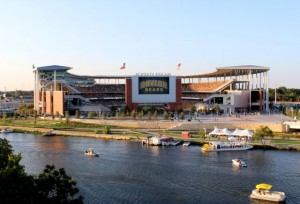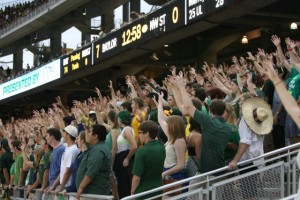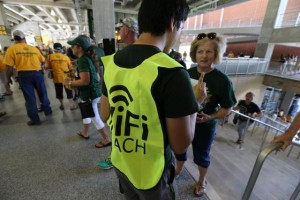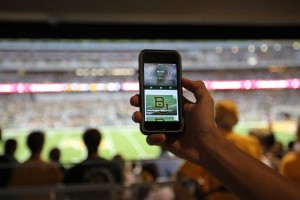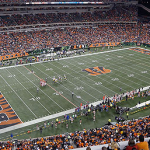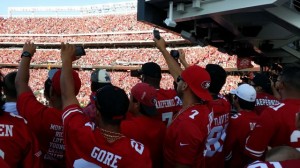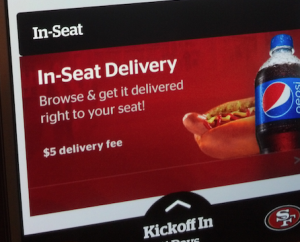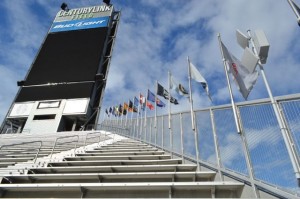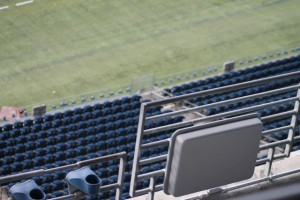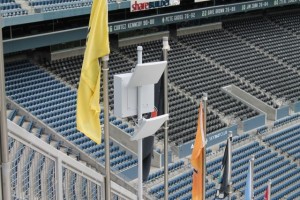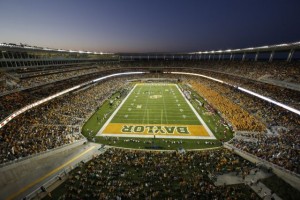
McLane Stadium, Baylor University. (click on any photo for larger image) Credit all photos: Baylor University
Now in its first season at the brand-new McLane Stadium, Baylor is already delivering an in-stadium fan technology experience that, like the team itself, ranks highly in the nation. Thanks to a Wi-Fi deployment from Extreme Networks, a DAS from AT&T and a new stadium app from sports-app leader YinzCam, Baylor is able to bring high-quality wireless connectivity to all parts of the 45,140-seat facility, along with advanced app features like live and on-demand streaming action video, as well as seating and parking maps for the new facility.
Like the recently opened Levi’s Stadium in Santa Clara, Calif., Baylor had an advantage with McLane Stadium in being able to make technology part of the original design, instead of having to retrofit it in later. “It’s an amazing opportunity to have a new stadium and be able to plan for technology from the bottom up,” said Pattie Orr, Baylor’s vice president for information technology and Dean of university libraries, in a recent phone interview. “It sure is nice to have technology in mind from the beginning.”
The house that RG3 built
But just like the Baylor team, the plan for the new stadium and its technology underpinnings had to come together quickly. Even late in the 2011 season, when then-Baylor quarterback Robert Griffin III was just starting to turn heads with his on-field heroics, the idea of building a new football facility on campus hadn’t yet been formally approved. In 2011, Baylor still played games in Floyd Casey Stadium, a 50,000-seat facility that opened in 1950, located about four miles from campus.And then, RG3 happened. As many people associated with Baylor will tell you, when the Bears and Griffin quickly vaulted into the national consciousness — especially after a dramatic RG3-led win over Oklahoma and his subsequent winning of the Heisman trophy — the push for a new stadium quickly gathered steam. (For more background, read this excellent history of the stadium’s origin from the Waco Tribune-Herald.)
“Two years ago we still weren’t sure the stadium was coming,” said Bob Hartland, associate vice president for IT infrastructure, who also participated in the phone interview. “Then there was the Heisman trophy, and everything started becoming a reality.”
After the university gave its formal approval in July of 2012, planning for the $266-million facility could begin — with Orr and Hartland’s tech team having to employ a bit of crystal-ball thinking.
“We knew we needed to deliver for mobile devices,” said Hartland. “The hard thing was trying to predict what was going to happen 2 years out [when the stadium would open].”
Bringing an ‘NFL experience’ to Waco
And even though Baylor is private and smaller than its Big 12 conference competitors, the IT team made no small plans. “We wanted an NFL experience,” Orr said. To her, that meant an interactive mobile app that delivered live video to each and every seat.
“The best thing we could do was be forward looking,” said Orr. “What we pictured was, ‘could we have it in our hands?’ In the stadiums of the past, fans loved the big screens, and they still do. But there’s nothing like having it right in the palm of your hand.”
Orr said the Baylor IT team visited some existing stadiums with advanced networks, like AT&T Stadium and Gillette Stadium, as part of a technology vetting process. Eventually the Baylor IT department whittled the Wi-Fi selection down to three different approaches — one that included under-the-seat antennas, one that proposed an under-the-concrete solution, and one that relied mainly on overhead APs. That final one, from Wi-Fi provider Extreme Networks, became the winning bid, in part because the Baylor team liked its less-intrusive technology.
“Overhead [APs] are just less intrusive, operationally,” said Hartland, noting the need to drill holes in concrete and do special cleaning or weather-hardening for under-the-seat APs. If you look at McLane, you can see multiple overhang areas around the entire seating bowl, which facilitates overhead AP placements. According to news reports, the Extreme Wi-Fi deployment has 330 APs.Baylor’s Orr also liked the Extreme Purview Wi-Fi analytics software, which provides detailed views of network usage.
“Analytics provide what you need to know,” Orr said. “If you’re in the dark on the fan experience, and don’t know which apps are being used, how can you tune it or make it better?”
On the DAS side, Baylor went with AT&T as the neutral host, though AT&T already has signed up main competitor Verizon Wireless as a client, meaning that the two largest providers of cellular service have enhanced coverage at McLane Stadium through the AT&T DAS, which reportedly has 486 antennas.
“Our goal was a high-density solution, for both cellular and Wi-Fi,” Orr said.
Solving for the standing-on-the-seat problem
While the network has been an early success — Orr said Baylor is already seeing Wi-Fi take rates as high as 33 percent of all attendees at games so far this season — there have also been a few interesting fixes that have been necessary, including re-tuning Wi-Fi APs to get around the interference quirk of students standing on their seats.Call it technology meeting tradition, with tradition winning: A Baylor tradition to have underclass students standing for the whole game turned into students standing on top of seats at their new section in McLane Stadium — a shift that led to unexpected interference with the original Wi-Fi antenna placements. (One of the quirks of Wi-Fi networks is that the water inside human bodies is a very effective blocker of Wi-Fi signals.)
“We had not anticipated the students standing on seats, and that extra 20 inches really made a difference,” Hartland said. According to another story in the local paper, large band instruments also blocked Wi-Fi signals. Hartland said that since the original problems the IT team and Extreme have developed work-arounds and new antenna placements to fix the issue.
“It’s pretty fantastic that our students are so excited,” said Orr of the standing-interference issue. “You don’t see things like that much at the NFL level.”
Live video and app ‘coaches’
On the app side, Baylor went with YinzCam, a company with numerous stadium apps under its belt for all the top U.S. professional leagues. YinzCam, like Extreme, is also a partner with the NFL, giving YinzCam an edge in winning NFL stadium deployments.
Like other stadium apps, the Baylor In-Game app from YinzCam features multiple camera-angle choices for replays and live streaming video, as well as a host of stats and other team information. Important to Baylor and its new stadium are maps that help direct fans to parking areas, as well as to specialty concession stands in a facility that is new to everyone this season.
“We have some well-known smoked onion rings [at the stadium] and the app can help fans find which stands are selling them and how to get there,” Orr said. The parking feature on the app, she said, can send text directions to fans. Also special to Baylor is a “brick finder,” an app that lets fans who participated in a stadium fundraiser find where the brick with their name on it is.One more NFL-like feature with a collegiate twist is Baylor’s embrace of the Extreme “Wi-Fi coaches” program, which has network-knowledgeable staff members walking around stadiums in highly visible gear offering hands-on help with connectivity and stadium app use. While Extreme has used the coaches program at pro venues like New England and Philadelphia, at Baylor Orr took advantage of in-house “talent,” using students in the MIS program as roaming “coaches,” giving them some real-world experience at network troubleshooting and customer service.
“We put them [the student coaches] in bright vests and have them stationed near concession stands, to offer a friendly face,” Orr said. “They’re terrific, and they give us real-time feedback.”
Orr said Baylor also has a journalism department student intern leading the technology team’s social media effort, which encourages fans to tweet out problems or questions they might have.
“With my gray hair I’m not too good on social media, but one thing I learned is that we need to embrace it,” said Orr. Hartland said that YinzCam reps told Baylor they “just need to get out there” on social media to support the app, and he reports pleasant surprises when the IT team tweets back.
“On social media, [fans] don’t expect to be contacted,” Hartland said. “They really appreciate it when we get back to them.”
